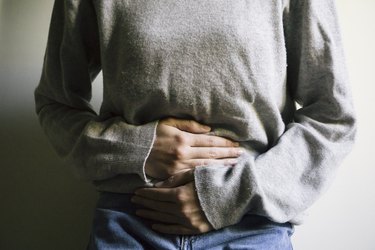
Diverticulitis, an infection that develops in pockets in the large intestine, might not be a health condition you're super-familiar with. But if the pain and discomfort of diverticulitis strike, one thing's certain: You'll want relief. The good news is that treatment is usually straightforward.
The Difference Between Diverticulosis and Diverticulitis
Video of the Day
For diverticulitis to develop, there must be pre-existing small pockets that have formed along the lining of the intestines, usually in the lower part of the large intestine, called the sigmoid colon, according to the National Institute of Diabetes and Digestive and Kidney Diseases (NIDDK). Having these pockets, or diverticula, is called diverticulosis.
Video of the Day
Pockets are thought to occur at weak spots along the intestine when pressure from waste and gas pass through the bowel, according to the Cleveland Clinic. They can range from pea-size to much larger, it says.
Diverticulosis is an extremely common condition and is probably linked to the average American diet, which is high in refined carbs. "Literally half the country has diverticulosis," says Neil Stollman, MD, chief of gastroenterology at Alta Bates Summit Medical Center in Oakland, Calif., and an associate clinical professor of medicine in the gastroenterology division at the University of California San Francisco.
Most people aren't even aware that they have diverticulosis, though it's something that you might learn of after a colonoscopy, says NIDDK. Often the pockets don't cause any trouble. But should one or more get infected and inflamed, the condition goes from diverticulosis to diverticulitis, with "itis" signifying intestinal inflammation.
Despite the large number of people with these pockets, only about 5 percent of Americans will develop diverticulitis over the course of their lifetimes, says NIDDK. The telltale symptoms of diverticulitis are abdominal pain, including cramps or spasms, nausea, vomiting and fever, according to the Mayo Clinic. Some people experience constipation, and diarrhea is possible but less common. It's also common to see rectal bleeding, Harvard Health reports. While you should call your doctor for any of these signs, get emergency care immediately if you have profuse bleeding.
Several tests may be needed to diagnose diverticulitis, according to the American Academy of Family Physicians. These can include a CT scan, a lower GI X-ray series, flexible sigmoidoscopy or colonoscopy.
Read more: Is Sugar Bad for Diverticulitis?
Diverticulitis Relief Treatment
Most cases of diverticulitis can be successfully treated with a course of antibiotics, according to the Mayo Clinic. There's some debate about whether antibiotics are needed for mild cases, but this is something to discuss with your doctor.
You'll probably need to follow a liquid diet for a few days to give your digestive tract a break so it can heal. Your doctor may recommend slowly adding solid food once you start to get better. While a fiber-rich diet can help prevent recurrences — as well as stem the development of diverticulitis in the first place, according to Dr. Stollman — follow your doctor's guidelines about when you can resume eating high-fiber foods and how much to have.
If you have a lot of discomfort, over-the-counter pain relievers such as acetaminophen (Tylenol) can help, Mayo adds, but be sure to ask if there are any you should avoid.
Surgery for Diverticulitis Complications
"Surgery has a role in a very small subset of people with diverticulitis," Dr. Stollman says. About 1 in 4 people with diverticulitis have complications, the Mayo Clinic says. The more serious ones, as well as more serious cases of diverticulitis itself, may warrant surgery.
NIDDK says possible complications include:
- An abscess, which is a pocket of pus that develops and requires drainage through a catheter (a small tube). Typically, the catheter is inserted by a radiologist and left in place for a number of days. If the abscess persists, surgery becomes more likely.
- A fistula, or tunnel, created as the infection spreads beyond the pocket. Surgery is usually needed to treat this complication.
- A stricture, which is a narrowing or blockage in a section of the colon that makes it hard or impossible for waste to pass through. Surgery is needed to correct this.
- Peritonitis, the most serious complication, is when the intestine ruptures and its contents spill into the abdomen. This requires immediate medical attention.
During surgery for these complications, the affected section of the colon is removed (bowel resection) and the two ends stitched together (anastomosis).
- American Academy of Family Physicians: “Diverticular Disease”
- Cleveland Clinic: “Diverticular Disease”
- Harvard Medical School, “Diverticular Disease of the Colon”
- Mayo Clinic: “Diverticulitis - Diagnosis and Treatment”
- National Institute of Diabetes and Digestive and Kidney Diseases: “Definition and Facts for Diverticular Disease”
- Mayo Clinic: "Diverticulitis - Symptoms and Causes"
Was this article helpful?
150 Characters Max
0/150
Thank you for sharing!
Thank you for your feedback!
Is this an emergency? If you are experiencing serious medical symptoms, please see the National Library of Medicine’s list of signs you need emergency medical attention or call 911.